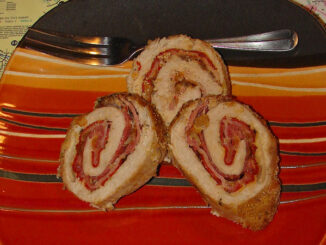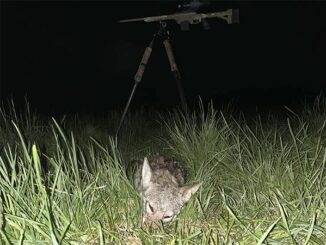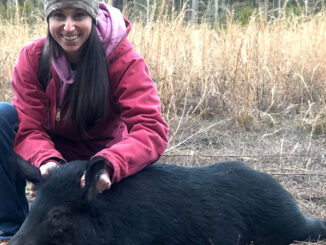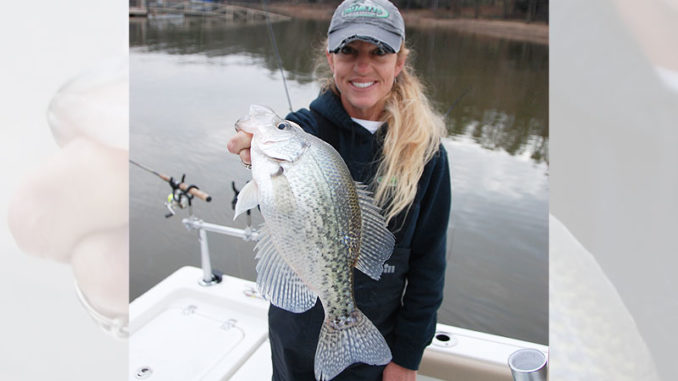
For deep winter crappie, try this vertical trolling tactic
This time of year, consistently finding and catching crappie can be a challenge. On many lakes and reservoirs across the Carolinas, winter crappie are typically deeper but ready to head shallow as soon as the weather breaks, and that can make the fishing tough.
The reason many anglers struggle with catching numbers of fish in deeper water has very little to do with the fish. Fortunately, crappie maintain a higher metabolism than most other gamefish species, which means if you can locate them and put something down there that gets their attention, you can catch them.
Before the term “spider-rigging” became a household word among crappie anglers, old-time anglers like William “Bud” Chambers of Kinards, S.C., were slow-trolling vertically in deep water where few anglers ever thought to look for crappie, much less during the winter.
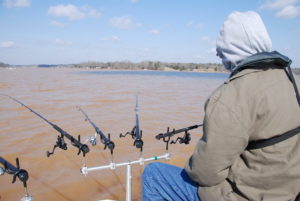
“This time of year, we’d always do what I called ‘deep fishing,’” Chambers said. “There’s two things I can accomplish by getting several baits down deep and slowly pushing them around for crappie. First, I’m watching my graph while I fish, and I can usually pick out a pattern where the fish are located that day. Might be a particular depth, might be some other feature, like a ditch or some old stumps, even if they are scattered over one particular area. The second is, I can put a bait right in his face.”
Long rods, live bait
Chambers uses long rods for his deep-water fishing, usually 12-footers. He rigs each rod with a 1- to 1½ ounce bank sinker at the end of his line, then ties a jig onto each dropper loop in the line, about two feet apart and one foot above the weight.
Most of the time, he uses live bait, hooking a minnow onto a marabou or hair jig that he threaded onto the line when he tied the rig. When the bite is steady, he may use a rubber tube jig just for the larger variety of colors, but when the bite gets slow, he’ll opt for the marabou or hair jig.
“I use a homemade marabou jig made by this guy up around Rock Hill,” he said. “I like bright colors if the water is clear and dark colors on the jig if the water is muddy.”
To position his rods and baits, Chambers uses two sets of rodholders around the bow of his boat. He uses two homemade T-bars and has two individual Driftmaster rodholders on each side of the T-bars.
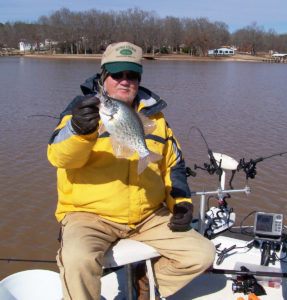
Watch your depth closely
The weighted jigs are pushing out in front of his boat, and he can feel his way along with the trolling rods. He said the heavy weights will slide over old wooden cover. He runs the majority of his baits close to the bottom but is insistent on hand counting the line out to the preferred depth rather than just dropping to the bottom and reeling up a little.
“I put a piece of tape on my rod exactly 2 feet from my reel” he explained. “Then I count off the depth pulling off 2-foot sections of line. I don’t like to drop the rig to the bottom and reel up even if I’m fishing just off the bottom, because I don’t like to slam the baits into the mud on the bottom. The hair will pick up mud and slime, and all I want in there is that fresh minnow scent.”
Numerous lakes are good for winter crappie
Chambers’ home lake is Lake Greenwood, but he fishes Lake Wateree and the smaller Catawba chain lakes: Fishing Creek and Stumpy Pond. He said all are great late-winter crappie lakes if you understand how the fish behave in cold water.
He said the smaller lakes are great for deep trolling because they are more riverine systems, but most of the major creek channels have silted in, which creates large expanses of deep water mud flats in the 20- to 35-foot depth range with some stain to the water, especially in the winter.
Chambers said he’d much rather find the right depth on a stained lake than to troll a deeper, clearer lake. He said the gently sloping mud flats are a plus for his deep, vertical-trolling, winter crappie methods.
“A lot of times these fish will just be laying in the mud, I guess it’s warmer for them doing that,” he said. “It’s not unusual to catch crappie with muddy bellies and tails. Most people never know they’re there but if you drag across an area you’ll pick one or two up here and there and most of these will be good fish.”
How to tie a loop knot
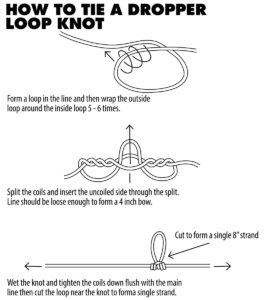 Many anglers shy away from using a true loop knot because it involves cutting the line. Most anglers simply make a loop in the main line and tie a figure 8 knot to create the loop. However, a true loop knot allows you to make a single-strand dropper out of each loop rather than a double-line loop. Using a single-strand greatly increases the sensitivity to a bite, especially when fishing for crappie in cold water.
Many anglers shy away from using a true loop knot because it involves cutting the line. Most anglers simply make a loop in the main line and tie a figure 8 knot to create the loop. However, a true loop knot allows you to make a single-strand dropper out of each loop rather than a double-line loop. Using a single-strand greatly increases the sensitivity to a bite, especially when fishing for crappie in cold water.
A loop-knot rig goes by a number of names including, bottom-bouncing rig, Kentucky rig and sharecropper Rig. The rig is tied using a heavy bell sinker or bank-casting sinker as a dropper weight to keep the rig vertical in the water even when being pushed with the trolling motor.
Tying the rig
To tie the rig, form a loop in the main line, then wrap the outside loop around the inside loop six times. Next, split the coiled line and insert the uncoiled line through the split in the line. Leave enough line to make a 4- to 5-inch loop, which will produce an 8- to 10-inch dropper. Wet the knot and tighten the coils down flush with the main line. Cut the loop close to the knot on one side to make the single strand dropper.
“If you tie this right, meaning you get it cinched down good where the line bites into the line, it’s near impossible to break,” veteran angler Bud Chambers said. “I’ve broken off hooks before I’ve had the knot break. It’s that strong.”
Chambers’ choice of line is 15-pound Berkeley Big Game. He saves time by using the heavy line to pull frequent hang-ups loose by straightening the light-wire jig hooks rather than retie broken rigs. He also said that the 15-pound line cuts through the water better than other lines of comparable diameter.

